The Productivity Solutions Grant (PSG) in Singapore offers a valuable opportunity for businesses to access funding for digital marketing initiatives, but should you focus on SEO or SEM? In this article, we’ll look at the differences between these two strategies to help you determine which is right for your business.
Understanding SEO
Search Engine Optimization (SEO) is the practice of enhancing your website’s visibility on search engines like Google through organic (non-paid) search results. By optimising various elements of your site, from content to technical aspects, SEO helps improve your rankings for relevant search queries over time.
Key components of SEO include keyword research, on-page optimization (like meta tags and content), off-page optimization (such as backlinks), and technical SEO (ensuring your site is mobile-friendly and fast). One of the most significant advantages of SEO is its long-term sustainability. Once your site is well-optimised, it can continue to attract organic traffic for months or even years without the need for ongoing expenses.
For businesses utilising the Productivity Solutions Grant, SEO offers a cost-effective way to build a strong digital foundation. By investing in SEO, you’re not just increasing your visibility; you’re also building trust and credibility with your audience. Over time, as your rankings improve, you’ll likely see a steady increase in organic traffic, leading to more leads and conversions.
Understanding SEM
Search Engine Marketing (SEM), on the other hand, involves paying for ads that appear on search engine results pages (SERPs). Unlike SEO, SEM offers immediate visibility for your business, placing your ads at the top of search results for specific keywords. This can be particularly advantageous for businesses looking to drive traffic quickly or promote time-sensitive offers.
Key components of SEM include keyword bidding, ad creation, and campaign management. One of the primary benefits of SEM is the level of control it offers—you can target specific demographics, set your budget, and adjust your campaigns in real-time to optimise performance.
For enterprises in Singapore applying for the Productivity Solutions Grant, SEM can provide quick wins, especially in competitive industries where organic rankings may take longer to achieve. With the ability to start generating traffic and leads almost immediately, SEM is an attractive option for businesses needing rapid results.
Comparing SEO and SEM
When deciding between SEO and SEM, several factors should be considered, including cost, timeframe, sustainability, and suitability for your business goals.
Cost:
- SEO typically requires an upfront investment in content creation, website optimization, and technical improvements. While the initial costs can be significant, the ongoing expenses are relatively low, making SEO a cost-effective strategy in the long run.
- SEM, conversely, involves continuous investment in ads. Costs can vary widely depending on the competitiveness of the keywords you’re targeting. While SEM can quickly drain your budget, it offers the advantage of immediate visibility.
Timeframe:
- SEO is a long-term strategy. It can take several months to see significant results, but once your site ranks well, the traffic it generates is consistent and free.
- SEM provides instant results. As soon as your ads are live, they start appearing in search results, driving traffic to your site. However, this visibility lasts only as long as your budget allows.
Sustainability:
- SEO is sustainable and offers long-lasting benefits. Once your site is well-optimised and ranks high in search results, it will continue to attract traffic without the need for ongoing ad spend.
- SEM is less sustainable in the long term since it requires continuous financial investment. Once you stop paying for ads, your visibility disappears.
Suitability:
- SEO is ideal for businesses looking to build a strong, long-term online presence. It’s particularly well-suited for enterprises that can wait for results and are focused on organic growth.
- SEM is better suited for businesses that need quick visibility, such as those launching a new product, running a time-sensitive promotion, or operating in highly competitive markets.
Which Strategy is Right for Your Business?
To determine which strategy aligns with your business goals, consider your specific needs and circumstances.
If your primary goal is to achieve immediate traffic and quick results, SEM might be the better option. For example, if you’re running a limited-time offer or need to generate leads quickly, SEM’s ability to deliver instant visibility can be invaluable. However, this approach requires a willingness to invest continuously in your campaigns.
On the other hand, if your business is focused on long-term growth and sustainability, SEO may be more beneficial. SEO allows you to build a strong digital presence over time, increasing your organic traffic and strengthening your brand’s credibility. With the Productivity Solutions Grant, enterprises in Singapore can offset the initial costs of SEO, making it a more accessible option for businesses looking to invest in their future.
Your budget also plays a crucial role in this decision. If you have a limited budget, SEO offers better long-term ROI since it doesn’t require continuous spending. However, if your budget allows for both, combining SEO and SEM can create a balanced approach, providing both immediate visibility and sustainable growth.
Combining SEO and SEM for Optimal Results
For many businesses, a balanced approach that incorporates both SEO and SEM can deliver the best results. By using SEM to generate immediate traffic while your SEO efforts gain traction, you can achieve both short-term and long-term success.
For example, you might launch an SEM campaign to promote a new product while simultaneously working on SEO to improve your organic rankings over time. This dual approach ensures that you’re capturing potential customers at all stages of the buying journey, maximising your reach and ROI.
Get Started with the PSG Digital Marketing Grant Today
If you’re ready to enhance your digital marketing efforts, the Productivity Solutions Grant offered by W360 Group is the perfect opportunity to get started. Whether you opt for SEO, SEM, or a combination of both, the PSG grant can help offset up to 50% of your digital marketing costs, making it easier for your business to thrive online.
Applying for the PSG grant is straightforward and efficient. W360 Group, a pre-approved PSG digital marketing vendor, will guide you through the entire process—from assessing your eligibility to selecting the most suitable digital marketing solutions for your business.
The benefits of tapping into the PSG grant are substantial. Not only will you receive financial support, but you’ll also gain access to W360 Group’s expertise in SEO, SEM, and other digital marketing strategies. This combination will empower your business to attract more customers, improve your online presence, and achieve sustainable growth in a competitive market.
Don’t miss out on this opportunity to transform your digital marketing with the help of the Productivity Solutions Grant. Contact W360 Group today to start your PSG grant application and take the first step toward a more successful digital future for your business.




